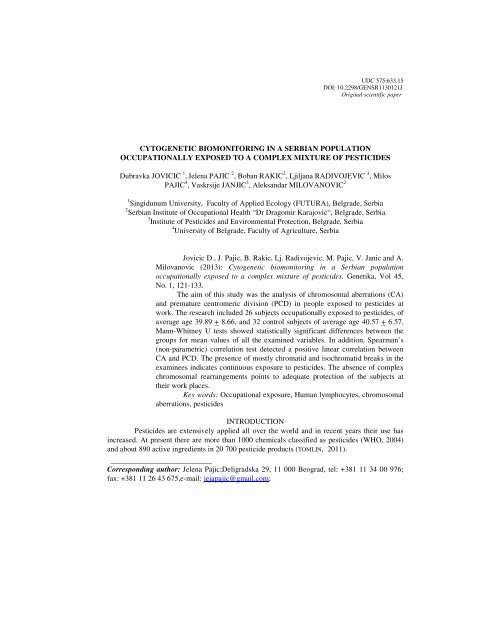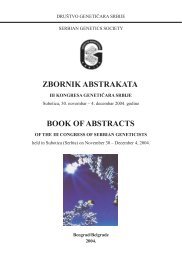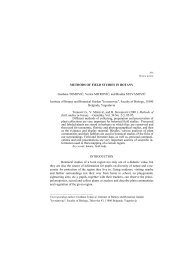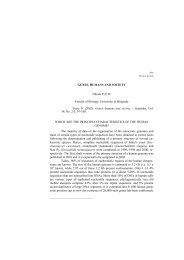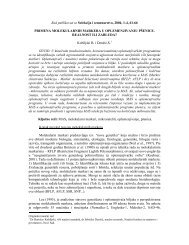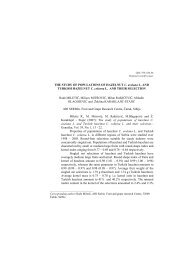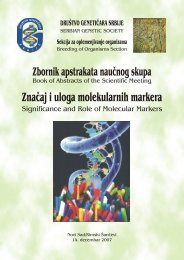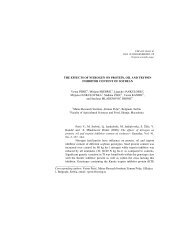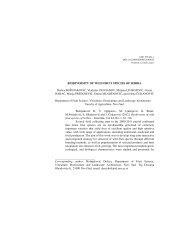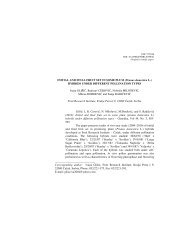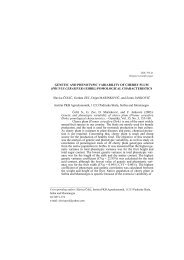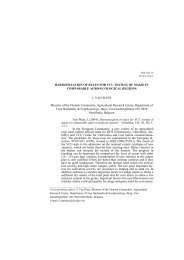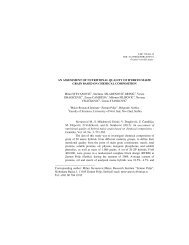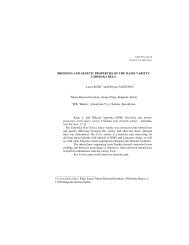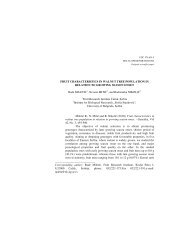Jelena Pajic;Deligradska 29, 11 000 Beograd, tel: +381 ... - doiSerbia
Jelena Pajic;Deligradska 29, 11 000 Beograd, tel: +381 ... - doiSerbia
Jelena Pajic;Deligradska 29, 11 000 Beograd, tel: +381 ... - doiSerbia
Create successful ePaper yourself
Turn your PDF publications into a flip-book with our unique Google optimized e-Paper software.
UDC 575:633.15<br />
DOI: 10.2<strong>29</strong>8/GENSR<strong>11</strong>30121J<br />
Original scientific paper<br />
CYTOGENETIC BIOMONITORING IN A SERBIAN POPULATION<br />
OCCUPATIONALLY EXPOSED TO A COMPLEX MIXTURE OF PESTICIDES<br />
Dubravka JOVICIC 1 , <strong>Jelena</strong> PAJIC 2 , Boban RAKIC 2 , Ljiljana RADIVOJEVIC 3 , Milos<br />
PAJIC 4 , Vaskrsije JANJIC 3 , Aleksandar MILOVANOVIC 2<br />
1 Singidunum University, Faculty of Applied Ecology (FUTURA), Belgrade, Serbia<br />
2 Serbian Institute of Occupational Health “Dr Dragomir Karajović“, Belgrade, Serbia<br />
3 Institute of Pesticides and Environmental Protection, Belgrade, Serbia<br />
4 University of Belgrade, Faculty of Agriculture, Serbia<br />
Jovicic D., J. <strong>Pajic</strong>, B. Rakic, Lj. Radivojevic, M. <strong>Pajic</strong>, V. Janic and A.<br />
Milovanovic (2013): Cytogenetic biomonitoring in a Serbian population<br />
occupationally exposed to a complex mixture of pesticides. Genetika, Vol 45,<br />
No. 1, 121-133.<br />
The aim of this study was the analysis of chromosomal aberrations (CA)<br />
and premature centromeric division (PCD) in people exposed to pesticides at<br />
work. The research included 26 subjects occupationally exposed to pesticides, of<br />
average age 39.89 + 8.66, and 32 control subjects of average age 40.57 + 6.57.<br />
Mann-Whitney U tests showed statistically significant differences between the<br />
groups for mean values of all the examined variables. In addition, Spearman’s<br />
(non-parametric) correlation test detected a positive linear correlation between<br />
CA and PCD. The presence of mostly chromatid and isochromatid breaks in the<br />
examinees indicates continuous exposure to pesticides. The absence of complex<br />
chromosomal rearrangements points to adequate protection of the subjects at<br />
their work places.<br />
Key words: Occupational exposure, Human lymphocytes, chromosomal<br />
aberrations, pesticides<br />
INTRODUCTION<br />
Pesticides are extensively applied all over the world and in recent years their use has<br />
increased. At present there are more than 1<strong>000</strong> chemicals classified as pesticides (WHO, 2004)<br />
and about 890 active ingredients in 20 700 pesticide products (TOMLIN, 20<strong>11</strong>).<br />
___________________________<br />
Corresponding author: <strong>Jelena</strong> <strong>Pajic</strong>;<strong>Deligradska</strong> <strong>29</strong>, <strong>11</strong> <strong>000</strong> <strong>Beograd</strong>, <strong>tel</strong>: <strong>+381</strong> <strong>11</strong> 34 00 976;<br />
fax: <strong>+381</strong> <strong>11</strong> 26 43 675,e-mail: jejapajic@gmail.com;
122 GENETIKA, Vol. 45, No.1,121-133, 2013<br />
The perfect pesticide should be toxic only to target organisms, be totally biodegradable<br />
to CO2 and H2O, and should not leave intermediate compounds in environment. Unfortuna<strong>tel</strong>y,<br />
this is rarely the case and widespread use of pesticides in the contemporary agriculture is of<br />
increasing concern. The main problems in real system arising from the use of pesticides in<br />
agriculture are their toxicity to non-target organisms and environment (ROS et al., 2006;<br />
RADIVOJEVIC et al., 2008; RADIVOJEVIC et al., 2012).<br />
Large amounts of these chemicals are released into the environment and being a<br />
potential hazard to human health. Toxicologic evidence of the carcinogenicity of several<br />
pesticides in animals, together with the fact that a large population of workers are exposed to<br />
such compounds, have attracted the attention of many studies (CARBONELL et al., 1995;<br />
PADMAVATHI et al. 2<strong>000</strong>; GOMEZ-ARROYO et al., 2<strong>000</strong>; ZELJEZIC et al., 2002; UNDEGER et al.,<br />
2002; GROVER et al. 2003; HEUSER et al. 2007; JOVICIC et al., 2012). With regard to genotoxicity,<br />
particular attention is focused on cytogenetic assays, because chromosome aberrations may be<br />
used as an early warning signal for cancer development. Data from the biomonitoring of human<br />
populations indicate that the increased frequency of chromosome aberrations is related to<br />
exposure to genotoxic agents, and may be employed to estimate cancer risk and genetic illness<br />
(WHO, 2004; HAGMAR et al. 2004). Biomonitoring studies using somatic cells have been<br />
extensively conducted to evaluate the possible genotoxic risk of a defined exposure and some<br />
indicators, such as chromosomal aberrations, have been shown to be relevant biomarkers for<br />
further cancer incidence (HAGMAR et al. 1998; IARC, 2007).<br />
Using data from cytogenetic biomonitoring studies for risk assessment has many<br />
potential disadvantages, such as the difficulty of establishing consistent causal exposure-disease<br />
relationships, problems in obtaining reliable information on exposure levels in retrospective<br />
studies, overlapping contact with other chemicals and/or the problem of non-comparable<br />
populations among those exposed to different levels of carcinogens (HCN, 1994). Moreover, in<br />
the case of occupational contact with pesticides, there is great interindividual variability in the<br />
degree of exposure and it generally involves complex mixtures of many kinds of compounds.<br />
Exposure to pesticides has been associated with increases in the incidence of non-Hodgkin ´ s<br />
lymphoma (HARDELL et al. 1999; ZHENG et al. 2001), pancreatic, stomach, liver and bladder<br />
cancer (SHUKLA et al. 2001; JI et al. 2001), Parkinson´s disease (GAUTHIER et al. 2001) and<br />
undesirable reproductive outcomes (ARBUCKLE et al. 2001) among others.<br />
Many pesticides involved in carcinogenic risk, and classified as probable or possible<br />
carcinogens by International Agencies, are banned or their use is restricted in some countries;<br />
but, due to bioaccumulation and persistence in ecosystems, they are widespread environmental<br />
pollutants. Residues of pesticides have been detected in the food chain and in different biological<br />
media in humans.<br />
In order to identify possible changes related to pesticide exposure, we have carried out a<br />
cross-sectional study in a group of occupationally exposed workers, where cytogenetic,<br />
biochemical and hematological parameters were analyzed simultaneously.<br />
MATERIALS AND METHODS<br />
The exposed group was composed of 26 individuals working in three different units of<br />
pesticide production (pesticide synthesis, emulsion concentrated production and powder and<br />
liquid pesticide production) and 32 controls. During the production process all subjects were<br />
simultaneously exposed to a complex mixture of pesticides (Table 1). No control individuals
D. JOVICIC et al: CYTOGENETIC BIOMONITORING IN OCCUPATIONAL EXPOSURE TO PESTICIDES 123<br />
were occupationally exposed to any particular chemical agent. Table 2 shows the characteristics<br />
of the studied groups regarding sex (male or female), age (in years), working experience (WE in<br />
years), duration of occupational exposure to pesticides (DOE in years), smoking habit (smoker or<br />
non – smoker), chromosomal aberrations (CAs) and premature centromeric division (PCD). The<br />
workers completed a specific questionnaire in which the type of working activity, duration of<br />
contact with pesticides, kinds of pesticides used, protective measures, etc., were recorded.<br />
Table 1. Pesticides used in the pesticide factory<br />
Herbicides Insecticides/Acricides Fungicides<br />
Active Class Active Class Active<br />
Class<br />
ingredient<br />
ingredient<br />
ingredient<br />
2,4 D Phenoxycarboxylic Abamectin - Copper<br />
Inorganic<br />
acid<br />
oxychloride<br />
Acetochlor Chloracetamide Acetamiprid Neonicotinoid Carbenadazim Benzimidazole<br />
Bentazone Benzothiadiazinone Bifenthrin Pyrethroid Chlorothalonil Chloronitrile<br />
Dicamba Benzoic acid Buprofezin Thiadiazine Difenoconazole Triazole<br />
Dichlobenil Benzonitrile Chlorpyrifos Organophosphate Fluazinam Toluidine<br />
Clethodim Cyclohexanedione<br />
oxime<br />
Cypermethrin Pyrethroid Iprodione Dicarboximide<br />
Clomazone Isoxazolidinone Fenitrothion Organophosphate Mancozeb Dithiocarbamate<br />
Clopyralid Pyridinecarboxylic<br />
acid<br />
Imidacloprid Neonicotinoid Pyrimethanil Anilinopyrimidine<br />
Fluroxypyr Pyridinecarboxylic Malathion Organophosphate Propamocarb Carabamate<br />
acid<br />
hydrochloride fungicide<br />
Glyphosate Glycine derivative Pyriproxyfen Juvenile hormone<br />
mimic<br />
Propineb Dithiocarbamete<br />
Linuron Urea Tebufenozide Diacylhydrazine Tebuconazole Triazole<br />
Nicosulfuron Sulfonylurea<br />
Paraquat Bipyridylium<br />
Pendimethalin Dinitroaniline<br />
Quizalofop-P Aryloxyphenoxypro<br />
pionate<br />
Sulcotrione Triketone<br />
Enzyme analysis<br />
Levels of serum alanine aminotransferase (ALT), aspartate aminotransferase (AST) and<br />
cholinesterase (SChE) were determined. These enzymes were analyzed spectrophotometrically<br />
using commercially available biochemical kits from Italy.<br />
Chromosomal aberrations (CAs) and premature centromeric division (PCD)<br />
CAs and PCD in lymphocytes were analyzed according to a standard protocol ((IAEA, 1986).<br />
Whole blood cultures were prepared using RPMI 1640 medium supplemented with 10% of fetal<br />
calf serum (Life technologies, http:// www.lifetechnology, com/). The lymphocytes were<br />
stimulated with phytohaemagglutinin (PHA, PAA) at 5 µg ml -1 for 48 h at 37°C. During the last<br />
2 h of incubation colchicine (0.05µg mL -1 ; Sigma – Aldrich, 3050 Spruce St., St. Louis, MO<br />
63103) was added to the medium. The cells were exposed to hypotonic solution (20 min) by<br />
stepwise addition of 0.075 M KCL followed by fixation. Cells were spread on slides and dried<br />
over a flame. The slides were aged for the next 5-7 days. Giemsa stained slides were coded and
124 GENETIKA, Vol. 45, No.1,121-133, 2013<br />
scored blind under a light microscope. Two hundred well-spread metaphases per subject were<br />
screened for PCD and chromosome damage. PCD was diagnosed when the separation between<br />
sister chromatids was equal to or more than the thickness of the chromatid (RUSHKOVSKY et al.<br />
2003).<br />
Table 2. General characteristics of the studied population<br />
Variable<br />
Exposed<br />
group<br />
Mean SD<br />
Age<br />
Working experience (WE)<br />
Duration of occupational exposure<br />
(DOE)<br />
Apartate aminotrasferase (AST),<br />
Alanine aminotransferase (ALT),<br />
Serum cholinesterase (SChE).<br />
Number aberrant cells<br />
Acentric<br />
Chromatid breaks<br />
Chromosome breaks<br />
tPCD<br />
PCD1-5<br />
PCD5-10<br />
Chromatid exchange<br />
control 40.57 6.57<br />
exposed 39.89 8.66<br />
control 16.23 6.25<br />
exposed 16.12 9.6<br />
control 0.00 0.00<br />
exposed <strong>11</strong>.56 7.42<br />
control 18.67 4.16<br />
exposed 22.19 5.80<br />
control 18.53 4.25<br />
exposed 27.58 12.49<br />
control 6951.00 1651.55<br />
exposed 9878.92 3593.94<br />
control 0.67 0.99<br />
exposed 4.35 2.35<br />
control 0.33 0.55<br />
exposed 1.19 1.1<br />
control 0.23 0.43<br />
exposed 2.27 1.04<br />
control 0.13 0. 35<br />
exposed 1.27 1.15<br />
control 0.23 0.50<br />
exposed 0.77 0.95<br />
control 1.17 1.02<br />
exposed 2.88 2.2<br />
control 0.40 1.31<br />
exposed 1.27 1.73<br />
control 0.00 0.00<br />
exposed 0.27 0.45<br />
Z -value p-value<br />
-0.39 0.690<br />
-0.25 0.800<br />
-6.97 0.<strong>000</strong>**<br />
-2.46 0.014*<br />
-3.65 0.<strong>000</strong>**<br />
-3.2 0.001**<br />
-5.64 0.<strong>000</strong>**<br />
-3.35 0.001**<br />
-6.12 0.<strong>000</strong>**<br />
-4.44 0.<strong>000</strong>**<br />
-2.34 0.020*<br />
-3.19 0.001**<br />
-2.43 0.015*<br />
-3.01 0.002**<br />
WE—working experience; DOE—duration of occupational exposure to pesticide tPCD—total number of chromosomes<br />
with PCD.<br />
a ns p < 0.05; * p < 0.01; **
D. JOVICIC et al: CYTOGENETIC BIOMONITORING IN OCCUPATIONAL EXPOSURE TO PESTICIDES 125<br />
Statistical analysis<br />
Frequencies of CAs: chromatid and chromosome breaks, acentrics, dicentrics and ring<br />
chromosomes, as well as PCD parameters, were evaluated for at least 200 metaphase cells. Three<br />
PCD parameters were included in the analysis: total number of chromosomes with PCD (tPCD)<br />
and frequencies of metaphase cells with 1-5 PCDs and 5-10 PCDs. In addition to descriptive<br />
statistics, appropriate non–parametric statistical methods were used (Mann–Whitney U-test,<br />
Pearson ´ s X 2 test and. Spearman rank test (non-parametric correlation test) on the whole sample<br />
(control-exposed) and the exposed group only. The software used for data analyses was<br />
STATISTICA (StatSoft, Tulsa,OK) and SPSS version10.0 (SPSS Inc., Chicago, IL).<br />
RESULTS<br />
Here we report the results of cytogenetic monitoring of 26 occupationally exposed<br />
workers and 32 matched controls using CA assays. The main objective was to show that<br />
exposure to pesticide mixtures in the manufacturing industry leads to an increase in cytogenetic<br />
damage.<br />
Table 2. gives the main characteristics of the population studied. The Mann-Whitney U-<br />
test indicated statistically significant differences of average values of all examined variables in<br />
comparison to the control group. The numbers of acentric fragments (p
126 GENETIKA, Vol. 45, No.1,121-133, 2013<br />
The number of exposed years during employment was significantly greater than for the<br />
control group of examinees. Only age and total length of employment showed no significant<br />
difference in comparison to the control group (Table 2).<br />
The frequency of PCD was expected to differ between the control and exposed<br />
individuals. We found that PCD frequency was significantly lower in the control than in the<br />
exposed group. JOVICIC et al. (2010) pointed to PCD as a marker of chromosome instability, so it<br />
was suggested that PCD is a suitable cytogenetic marker for workers professionally exposed to<br />
mutagenic agents. This could be explained partially by the observations of IKEUTCHI et al.<br />
(2004), who showed that PCD could be induced by an increasing hypotonic treatment (technical<br />
procedure). Other authors suggested that PCD might depend on the action of yet unknown<br />
environmental factors to which subjects from the control group were exposed (MAJOR et al.<br />
1999).<br />
Positive results for chromosomal aberration tests after occupational exposure to a<br />
mixture of pesticides were reported earlier (BOLOGNESI, 2003; ANTONUCCI et al. 2<strong>000</strong>;<br />
BOLOGNESI et al. 2009; EL-KHATIB et al. 2003). Similar results were obtained for a population<br />
monitored in Croatia, (CARBONELL et al. 1995; ZELJEZIC et al. 2002), i.e. the workers exposed<br />
were protected against pesticide fog but presented a frequency of CAs higher than controls.<br />
Statistically significant increases in the number of all types of chromatid and chromosome<br />
aberrations, sister chromatid exchanges frequency, micronucleus frequency and comet assay<br />
endpoint values observed in exposed subjects may indicate longterm occupational contact with a<br />
complex pesticide (GARAJ-VRHOVAC et al. 2001).<br />
Table 3. Results of Pearson ´ s X 2 test for the variables examined<br />
Variable χ2 Degrees of freedom DF p<br />
Chromatid breaks <strong>11</strong>.515 4 0.020 *<br />
Chromosome breaks 10.099 3 0.018*<br />
DF- degrees of freedom P
D. JOVICIC et al: CYTOGENETIC BIOMONITORING IN OCCUPATIONAL EXPOSURE TO PESTICIDES 127<br />
Considering smoking habits, Pearson´s X 2 test showed that, regardless of whether<br />
workers are exposed or not, isochromatic and chromatic breaks occur more frequently among<br />
smokers. Thus, 79% of smokers had one or more chromatid breaks, whereas non-smokers had<br />
46%. Moreover, 63% of smokers had one or more isochromatid breaks, while non-smokers had<br />
27%. The results of Pearson ´ s X 2 test are shown in Table 3, while the frequency of the tested<br />
parameters is given in Table 4.<br />
DISCUSSION<br />
Cytogenetic damage in individuals occupationally exposed to pesticides has received<br />
the attention of investigators in several countries but no definitive conclusions have yet been<br />
made. Reviews on this matter (BOLOGNESI, 2003; BULL et al. 2006) suggest that most studies<br />
found increases in biomonitoring indices of genotoxicity in pesticide applications. Work<br />
environment, time of exposure and exposure conditions are described as factors affecting<br />
cytogenetic damage levels (KHUDER et al. 1997; BHALLI et al. 2006). Another factor<br />
complicating comparison of different studies performed to date is the large number and variety<br />
of chemicals generally used.<br />
Similarly to our results, ANTONUCCI et al. (2<strong>000</strong>) observed that exposed and control<br />
subjects did not differ significantly in terms of smoking habits as observed with the statistical<br />
test used. BONNER et al. (2010) reported that workers who smoke and are exposed to pesticides<br />
exhibited a significant increase in total chromosomal aberrations compared to non-smokers who<br />
had no contact with pesticides. Although some studies showed higher levels of cytogenetic<br />
biomarkers in smokers than non–smokers (CARBONELL et al. 1990), BHALLI et al. (2006)<br />
reported that smoking has an additive effect on the frequency of BNMN (binucleated<br />
lymphocytes with micronucleus) and MNL (number of micronuclei in binucleated lymphocytes).<br />
Some other confounding factors like smoking habit and exposure time were also analyzed. Thus,<br />
smoking had an additive effect on the frequency of BNMN and MNL, which was reflected by<br />
more BNMN and MNL in lymphocytes of smokers than of non-smokers. On the other hand,<br />
micronuclei analyses conducted by Lucero (LUCERO et al. 2<strong>000</strong>) and PASTOR et al. (2002)<br />
showed that smoking habits did not cause any significant elevation in chromosomal aberrations.<br />
In our exposed group, the length of exposure during employment only had an influence on<br />
PCD5-10 (p
128 GENETIKA, Vol. 45, No.1,121-133, 2013<br />
tPCD, PCD1-5, PCD5-10 variables. For biochemical parameters, significant positive correlations<br />
occurred in ALT, SChE and ALT (Table 6).<br />
Table 5. Influence of duration of exposure (DOE) on the genetic and biochemical parameters.<br />
Results Pearson ´ s X 2 test<br />
Variables χ2 DF p-value<br />
Number aberrant cells <strong>11</strong>.41 9 0.25<br />
Acentric 5.66 4 0.23<br />
Chromosome breaks 4.99 3 0.17<br />
Chromatid breaks 6.83 4 0.15<br />
tPCD 2.01 3 0.57<br />
PCD1-5 9.44 7 0.22<br />
PCD5-10 12.39 4 0.02*<br />
Chromatid exchange 0.46 1 0.49<br />
Aneuplody 4.34 5 0.50<br />
Polyploidy 0.89 2 0.64<br />
SChE 26.00 25 0.41<br />
ALT 15.94 18 0.60<br />
AST 17.96 17 0.39<br />
DF - degrees of freedom,<br />
Marginally significant P
Exposed<br />
group<br />
Number<br />
aberrant<br />
cells<br />
D. JOVICIC et al: CYTOGENETIC BIOMONITORING IN OCCUPATIONAL EXPOSURE TO PESTICIDES 1<strong>29</strong><br />
Table 6 .Spearman rank (nonparametric) correlations between variable pairs for the whole sample below<br />
diagonal and the exposed group above diagonal<br />
Number<br />
aberrant<br />
cells Acentric breaks<br />
Chromatid Chromosome<br />
breaks tPCD<br />
PCD<br />
1-5<br />
PCD<br />
5-10<br />
Chromatid<br />
ALT<br />
exchange Aneuploidy Polyploidy (U/L)<br />
AST<br />
(U/L)<br />
serum<br />
cholinesterase<br />
(SChE).<br />
0.761 ** 0.452 ** 0.825 ** 0.599 ** 0.316 * 0.430 ** 0.327 * 0.406 ** 0.361 ** 0.255 0.492 ** 0.331 * 0.431 **<br />
0.759 ** 0.9<strong>11</strong> ** 0.802 ** 0.632 ** 0.491 ** 0.416 ** 0.525 ** 0.521 ** 0.285 * 0.573 ** 0.334 * 0.414 **<br />
Acentric 0.568 ** 0.584 ** 0.569 ** 0.370 ** 0.356 ** 0.289 * 0.548 ** 0.309 * 0.407 ** 0.231 0.303 *<br />
Chromatid<br />
breaks<br />
Chromosome<br />
breaks<br />
(U/L)<br />
0.678 ** 0.4<strong>11</strong> ** 0.528 ** 0.408 ** 0.506 ** 0.454 ** 0.186 0.559 ** 0.319 * 0.508 **<br />
0.638 ** 0.492 ** 0.546 ** 0.604 ** 0.593 ** 0.226 0.557 ** 0.366 ** 0.204<br />
tPCD 0.183 0.242 0.614 ** 0.437 ** 0.371 ** 0.332 * 0.240 0.2<strong>11</strong><br />
PCD 1-5 0.648 ** 0.354 ** 0.564 ** -0.008 0.431 ** 0.367 ** 0.316 *<br />
PCD 5-10 0.424 ** 0.622 ** 0.007 0.401 ** 0.260 0.181<br />
Chromatid<br />
exchange<br />
0.533 ** 0.154 0.<strong>29</strong>7 * 0.204 0.254<br />
Aneuploidy 0.121 0.396 ** 0.220 0.179<br />
Polyploidy<br />
ALT (U/L)<br />
AST (U/L)<br />
*p
130 GENETIKA, Vol. 45, No.1,121-133, 2013<br />
observations indicate the need to increase the preventive measures habitually used by staff<br />
occupationally exposed to pesticides. Our results were obtained from a preliminary examination<br />
on a relatively small sample, so further studies including a larger number of subjects combined<br />
with investigations in vitro should be performed in order for the observed phenomena to be<br />
understood better. They also indicate the need for permanent biomonitoring of subjects<br />
occupationally exposed to various mixtures of pesticides, using a variety of cytogenetic methods.<br />
ACKNOWLEDGMENTS<br />
This research was funded by the Ministry of Education and Science of the Republic of Serbia,<br />
through implementation of the project “Studies on plant pathogens, arthropods, weeds and<br />
pesticides with a view to developing the methods of biorational plant protection and safe food<br />
production” (TR31043).<br />
Received December 21 st , 2012<br />
REFERENCES<br />
Accepted March 12 th , 2012<br />
ANTONUCCI, G., I. COLUS (2<strong>000</strong>): Chromosomal aberrations analysis in a Brazilian population exposed to pesticides.<br />
Teratog Carcinog Mutagen 20:265–272<br />
ARBUCKLE, TE., L.LIN, L.S. MERY (2001): An exploratory analysis of the effect of pesticide exposure on the risk of<br />
spontaneous abortion in an Ontario farm population. Environ Health Perspect 109:851–857<br />
BHALLI, JA., QM. KHAN, MA..HAQ, AM KHALID, A.NASIM (2006): Cytogenetic analysis of Pakistani individuals<br />
occupationally exposed to pesticides in a pesticide production industry. Mutagenesis 21:143–148<br />
BOLOGNESI, C. (2003) Genotoxicity of pesticides: a review of human biomonitoring studies. Mutat Res 543:251–272<br />
BOLOGNESI, C., E.LANDINI, E.PERRONE, P. ROGGIERI (2004): Cytogenetic biomonitoring of a floriculturist population in<br />
Italy: micronucleus analysis by fluorescence in situ hybridization (FISH) with an all-chromosome centromeric<br />
probe. Mutat Res 557:109–<strong>11</strong>7<br />
BOLOGNESI, C., G.CARRASQUILLA, S.VOLPI, KR.SOLOMON, EJ. MARSHALL (2009): Biomonitoring of genotoxic risk in<br />
agricultural workers from five Colombian regions: association to occupational exposure to glyphosate. J<br />
Toxicol Environ Health Part A 72:986–997<br />
BONNER, MR., BA. WILLIAMS, JA.RUSIECKI, A.BLAIR, LE.BEANE FREEMAN, JA.HOPPIN, M DOSEMECI., J. LUBIN, DP.,<br />
SANDLER MC. ALAVANJA (2010) :Occupational exposure to terbufos and the incidence of cancer in the<br />
Agricultural Health Study. Cancer Causes Control 21: 871–877.<br />
BULL, S., K.FLETCHER, AR.BOOBIS, JM. BATTERSHILL (2006): Evidence for genotoxicity of pesticides in pesticide<br />
applicators: a review. Mutagenesis 21:93–103<br />
CARBONELL, E., M.PUIG, N.XAMENA, A.CREUS, R. MARCOS (1990): Sister chromatid exchanges in lymphocytes of<br />
agricultural workers exposed to pesticides. Mutagenesis 5:403–405<br />
CARBONELL, E., A.VALBUENA, N.XAMENA, A.CREUS, R. MARCOS (1995): Temporary variations in chromosomal<br />
aberrations in a group of agricultural workers exposed to pesticides. Mutat Res 344:127–134<br />
COSTA, C., JP. TEIXEIRA, S. SILVA (2006): Cytogenetic and molecular biomonitoring of a Portuguese population exposed<br />
to pesticides. Mutagenesis 21:343–350<br />
DA SILVA, J.., CR. MORALES, D. VANINA, V. HEUSER, M. ANDRADE, FR. SILVA (2008): Evaluation of genetic damage in a<br />
Brazilian population occupationally exposed to pesticides and its correlation with polymorphisms in<br />
metabolizing genes. Mutagenesis 23:415–422
D. JOVICIC et al: CYTOGENETIC BIOMONITORING IN OCCUPATIONAL EXPOSURE TO PESTICIDES 131<br />
EL-KHATIB, H, F. HAMMAM (2003): in: Human Monitoring for Genetic Effects, Cebulska-Wasilewska A, Au WW, Sram<br />
RJ (Eds.) NATO Science Series, Springer p. 142<br />
GARAJ-VRHOVAC, V, D. ZELJEZIC (2001): Cytogenetic monitoring of Croatian population occupationally exposed to a<br />
complex mixture of pesticides. Toxicology 165:153–162<br />
GAUTHIER, E, I. FORTIER, F. COURCHESNE, P. PEPIN, J. MORTIMER, D.GAUVREAU (2001): Environmental pesticide exposure<br />
as a risk factor for Alzheimer’s disease: a case-control study. Environ Res 86:37–45<br />
GOMEZ-ARROYO, S., Y DIAZ-SANCHEZ, M. MENESES-PEREZ, R. VILLALOBOS-PIETRINI, JL. RODRIGUEZ (2<strong>000</strong>): Cytogenetic<br />
biomonitoring in a Mexican floriculture worker group exposed to pesticides. Mutat Res 466:<strong>11</strong>7–124<br />
GROVER, P., K. DANADEVI, M. MAHBOOB, RB. ROZATI, BS. BANU, MF. RAHMAN (2003): Evaluation of genetic damage in<br />
workers employed in pesticide production utilizing the Comet assay. Mutagenesis 18:201–205<br />
HAGMAR, L., S. BONASSI, U. STROMBERG, A. BROGGER, L. KNUDSEN, H. NORPPA, C. REUTERWALL (1998):ort from the<br />
European study group on cytogenetic Biomarkers and Health (ESCH). Cancer Res 64:159–163<br />
HAGMAR, L., U. STROMBERG, S. BONASSI, IL. HANSTEEN, L. KNUDSEN, C. LINDHOLM, H. NORPPA (2004): Impact of types of<br />
lymphocyte chromosomal aberrations on human cancer risk. Results from Nordic and Italian cohorts. Cancer<br />
Res 64:2258–2263<br />
HARDELL, L., M. ERIKSSON (1999): A case-control study of non-Hodgkin lymphoma and exposure to pesticides. Cancer<br />
85:1353–1360<br />
HEALTH COUNCIL OF THE NETHERLANDS (HCN) (1994): Committee on the evaluation of the carcinogenicity of chemical<br />
substances. Regul Toxicol Pharmacol 19:14 – 30<br />
HEUSER, VD., B. ERDTMANN, K. KVITKO, P. ROHR, J. DA SILVA (2007): Evaluation of genetic damage Brazilian footwear–<br />
workers: biomarkers of exposure, effect and susceptibility. Toxicology 232:235–247<br />
IAEA, (1986: Biological dosymetry: chromosome aberration analysis for dose assessment, In. Technical Reports Series<br />
No. 260, International Atomic Energy Agency, Vienna, pp.59–63<br />
IKEUTCHI, T., ZQ. YANG, K. WAKAMATSU, T. KAJI (2004): Induction of premature chromatid separation (PCS) in<br />
individuals with PCS trait and in normal controls. Am J Med Genet Part A 127:128–132<br />
INTERNATIONAL AGENCY FOR RESEARCH ON CANCER (IARC) (2007): Monographs on the Evaluation of Carcinogenic<br />
Risk to Human. World Health Organization, Lyon, France<br />
JI, BT., DT. SILVERMAN, PA.STEWART (2001): Occupational exposure to pesticides and pancreatic cancer. Am J Ind Med<br />
39:92–99<br />
JOVICIC, D., S. MILACIC, T. VUKOV, B. RAKIC, M. STEVANOVIC, DRAKULIC, R. RAKIC, N. BUKVIC (2010): Detection of<br />
premature segregation of centromeres in persons exposed D to ionizing radiation. Health Physics 98:717–727.<br />
JOVICIC, D., J. PAJIC, B. RAKIC, LJ. RADIVOJEVIC, M. PAJIC, S. GASIC, LJ. SANTRIC (2012):Cytogenetic effect in a Serbian<br />
population occupationally exposed to a complex mixture of pesticides. Abstracts of International MGPR<br />
Meeting 2012 and International Conference on Food and Health Safety: Moving Towards a Sustainable<br />
Agriculture, Belgrade, Serbia, 82<br />
JOVICIC, D., J.PAJIC, B.RAKIC, LJ.RADIVOJEVIC, A.DJORDJEVIC, M. PAJIC, V.ЈANJIC (2012): Evaluation of cytogenetic<br />
changes in workers occupationally exposed to pesticides. In Proceedings of the International Congress<br />
"Ecology, health, work and sport", Banja Luka, 605-609<br />
LUCERO, L., S. PASTOR, S. SUAREZ, R. DURBAN, C. GOMEZ, T. PARRON, A..CREUS, R. MARCOS (2<strong>000</strong>): Cytogenetic<br />
biomonitoring of Spanish greenhouse workers exposed to pesticides: micronuclei analysis in peripheral blood<br />
lymphocytes and buccal epithelial cells. Mutation Research 464: 255–262<br />
MAJOR, J., MG JAKAB, A. TOMPA (1999): The frequency of induced premature centromere division in human populations<br />
occupationally exposed to genotoxic chemicals. Mutat Res 445:241–249<br />
PADMAVATHI, P., PA. PRABHAVATHI, PP. REDDY (2<strong>000</strong>): Frequencies of SCEs in peripheral blood lymphocytes pesticide<br />
workers. Bull Environ Contam Toxicol 64:155–160
132 GENETIKA, Vol. 45, No.1,121-133, 2013<br />
PASTOR, S., A,.CREUS N. XAMENA, C. SIFFEL, R. MARCOS (2002): Occupational exposure to pesticides and cytogenetic<br />
damage: results of a Hungarian population study using the micronucleus assay in lymphocytes and buccal<br />
cells. Environmental and Molecular Mutagenesis 40: 101–109<br />
PASTOR, S., A.CREUS, N T., PARRO´ A.CEBULSKA-WASILEWSKA, C.SIFFEL, S. PIPERAKIS, R. MARCOS (2003): Biomonitoring<br />
of four European populations occupationally exposed to pesticides: use of micronuclei as biomarkers.<br />
Mutagenesis, 18, 249–258<br />
PIPERAKIS, SM, E.PETRAKOU, S.TSILIMIGAKI, M.SAGNOU, E.MONOGIUDIS, G.HANIOTAKIS, H.KARKASELI, E. SARIKAKI<br />
(2003): Biomonitoring with the comet assay of Greek greenhouse workers exposed to pesticides. Environ Mol<br />
Mutagen 41:104–<strong>11</strong>0<br />
RADIVOJEVIC, LJ., S. GASIC, LJ. SANTRIC, R.STANKOVIC-KALEZIC (2008): The impact of atrazine on several biochemical<br />
properties of chernozem soil. Journal of Serbian Chemical Society 73: 951-959<br />
RADIVOJEVIC, LJ., S. GASIC, LJ. SANTRIC, J. GAJIC UMILJENDIC, D. MARISAVLJEVIC (2012) :Short-time effects of the<br />
herbicide nicosulfuron on the biochemical activity of chernozem soil. Journal of Serbian Chemical Society 77:<br />
845-854<br />
REMOR, AP, AC TOTTI, DA MOREIRA, GP DUTRA, VD HEUSER, JM BOEIRA (2009): Occupational exposure of farm workers to<br />
pesticides: biochemical parameters and evaluation of genotoxicity. Environ Int 35:273–278<br />
ROS, M., M. GOBERNA, JL MORENO, T. HERNANDEZ, C. GARCIA, H. INSAM, JA PASCUAL (2006): Molecular and<br />
physiological bacterial diversity of a semi-arid soil contaminated with different levels of formulated atrazine.<br />
Applied Soil Ecology 34: 93-102<br />
RUSHKOVSKY, SR, YV PETRENKO, VF BEZRUKOV (2003): Premature centromere division as a biomarker of genotoxic<br />
influences. In Abstract book of the sixth international symposium and exhibition on environmental<br />
contamination in Central and Eastern Europe and the Commonwealth of independent status, pp.1–4. Prague,<br />
Czech Republic<br />
SHAHAM, J., Z. KAUFMAN, R.GURVICH, Z. LEVI (2001): Frequency of sister-chromatid exchange among<br />
greenhouse farmers exposed to pesticides. Mutatation Research 491: 71–80<br />
SHUKLA, VK, AN RASTOGI, TK ADUKIA, RB RAIZADA, DCS REDDY, S. SINGH (2001): Organochlorine pesticides in<br />
carcinoma of the gallbladder: a case-control study. Eur J Cancer Prev 10:153–156<br />
TOMLIN, CDS. (20<strong>11</strong>): The Pesticide Manual. Seventeenth Ed., British Crop Protection Council, Farnham, Surrey, UK.<br />
UNDEGER, U., N. BASARAN (2002): Assessment of DNA damage in workers occupationally exposed to pesticide mixtures<br />
by the alkaline comet assay. Genotoxicity 76:430–436<br />
WORLD HEALTH ORGANIZATION (WHO) (2004): The WHO Recommended Classification of Pesticides and Guidelines to<br />
Classification. World Health Organization, Geneva<br />
ZELJEZIC, D., V. GARAJ-VRHOVEC (2002) :Sister chromatid exchange and proliferative rate index in the longitudinal risk<br />
assessment of occupational exposure to pesticides. Chemosphere 46:<strong>29</strong>5–303<br />
ZHENG, T., SH. ZAHM, KP. CANTOR, DD. WEISENBURGER, Y. ZHANG, A. BLAIR (2001): Agricultural exposure to carbamate<br />
,<br />
pesticides and risk of non-Hodgkin lymphoma. J Occup Environ Med 43:641–649
D. JOVICIC et al: CYTOGENETIC BIOMONITORING IN OCCUPATIONAL EXPOSURE TO PESTICIDES 133<br />
CITOGENETIČKA ISTRAŽIVANJA RADNIKA SRBIJE PROFESIONALNO<br />
IZLOŽENIH PESTICIDIMA<br />
Dubravka JOVIČIĆ 1 , <strong>Jelena</strong> PAJIĆ 2 , Boban RAKIĆ 2 , Ljiljana RADIVOJEVIĆ 3 ,<br />
Miloš PAJIĆ 2 , Vaskrsije JANJIĆ 3 , Aleksandar MILOVANOVIĆ 2<br />
1 Univerzitet Singidunum, Fakultet za primenjenu ekologiju (FUTURA), <strong>Beograd</strong>, Srbija<br />
2 Institut za medicinu rada Srbije „Dr Dragomir Karajović“, <strong>Beograd</strong>, Srbija<br />
3 Institut za pesticide i zaštitu životne sredine, <strong>Beograd</strong>, Srbija<br />
4 Univerzitet u <strong>Beograd</strong>u, Poljoprivredni falkultet, <strong>Beograd</strong>, Srbija<br />
Izvod<br />
Cilj istraživanja bila je analiza hromozomskih aberacija (CA) i prevremene centromerne<br />
deobe (PCD) kod lica profesionalno izloženih pesticidima. Istraživanja su obuhvatala 26<br />
ispitanika profesionalno izloženi pesticidima prosečne starosti 39.89+ 8.66 i 32 ispitanika<br />
kontrolne grupe prsečne starosti 40.57+ 6.57. Mann-Whitney U test pokazuje statistički značajnu<br />
razliku srednjih vrednosti parametara svih ispitivanih varijabli u odnosu na kontrolnu grupu.<br />
Osim toga, Spearmanova (neparametarska) korelacija je pokazala da postoji pozitivna linearna<br />
korelacija između CA i PCD. Prisustvo uglavnom hromatidnih i izohromatidnih prekida kod<br />
ispitanika ukazuju na kontinuirano izlaganje pesticidima. Odsustvo složenih hromozomskih<br />
rearanžmana ukazuje na dobru zaštitu ispitanika na njihovim radnim mestima.<br />
Primljeno 21. XII 2012.<br />
Odobreno 12. III.2012.


